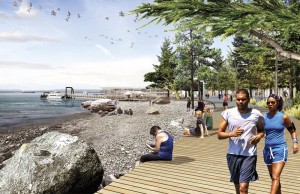The Seattle Times recently had a front page story on what Seattle’s new waterfront might look like. Back in 2009, the city began work on this project, hiring “rock-star landscape architect James Corner, designer of the celebrated High Line in New York City” to develop the big picture. (Note: I’ve been to the High Line and have posted on it before – it’s fantastic.) As you can see from the linked article from the Times, many of Corner’s architectural renditions for the greenway are presented, including this one:

COURTESY OF JAMES CORNER FIELD OPERATIONS AND CITY OF SEATTLE
An architectural rendering shows what a Pioneer Square beach at the foot of Washington Street could look like.
For those of you not familiar with Seattle’s waterfront, it’s built right next to Puget Sound, a huge inland sea connected at its mouth to the Pacific Ocean. So it was with much surprise that I saw what appear to be Douglas firs (Pseudotsuga menziesii) along the cobbled beach. Douglas firs are not particularly salt tolerant, nor would they be very happy with the tidal action or seasonal storms that will flood the beach on a regular basis. Even if these were not Douglas firs (native to Seattle) but some other salt-tolerant species (mangroves?), it’s doubtful they would look as picturesque as the drawing shows. Neither would the rest of the trees in the area, whose root zones would normally extend far into saline soils under the beach and sound.
Am I being picky? No, I don’t think so. Landscape architects should know better than to use plantings as decorations for their designs, like candy sprinkles on cupcakes. Plants aren’t just design elements. Choosing plants that are appropriate to a site is a science as well as an art.
I can’t believe that in the five years that Seattle’s been working on this project that horticultural science hasn’t been a major component of landscape planning.
It looks like the rendering is computer generated and edited. Who knows if the person who put this together has any plant knowledge, or was given any direction in what plant images to use. I’d like to see Mr. Corner’s designs and plant lists; I’m hopeful he’s made wiser choices. Still, using plant material as artistic pieces without siting considerations is a very common problem in the industry. Too bad landscape architectural firms don’t all keep a certified nurseryperson on staff to knock some gardening sense into them, when neccesary.
When I saw that rendering my mind immediately went to all the squawking about views that would quickly ensue …. It does make one wonder about the proper tree choice so close to a saltwater beach.
Unfortunately, this is all too common a scenario in the green business. The LA with 1, 5 hour course in horticulture has the final say on plant selection.
IME I find it rare to meet a LA with plant knowledge.
Best,
D
Another landscape practice I see a lot of when planting trees is the mountain landscapers build around the base of newly planted trees. A few years later they are all suffering or dead. However, they continue to plant this way.
I’m a landscape architect, and happily work with horticulturists in designing my landscapes. I love plants, but as Clint Eastwood said in the movie Magnum Force, “A man’s got to know his limitations,” and I learned long ago I get the best results form partnering with experts.
I agree with the assessment that LA’s often know very little about plants and designing with them. As a garden designer, its frustrating to be passed up for quality projects because I don’t have that degree, yet I have 25 years of knowledge and experience and I’m as good a designer as it gets. I guess I wasted my time in college majoring in art!
A grove of appropriate willows or alders would be stunning along that promenade, I think.
And Rick, I’m in Atlanta…